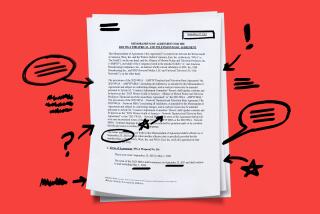Prime-Time Invasion of the Infomercials
- Share via
The Kitman Law almost tells it all:
“If it moves,” Newsday television columnist Marvin Kitman declared, “the public will watch it.”
With apologies to the author, his law could use an asterisk:
“If it’s on television, move it out.”
This variant Law* is becoming more evident in television programming as 30-minute, after-hour infomercials (commercials masquerading as talk shows, panel discussions, cooking classes and self-improvement seminars) creep steadily into prime time in a sort of Invasion of the Money Snatchers.
For many television executives it’s like an uncertain relationship: They can’t live with infomercials, but they can’t live without them, either. That’s what a lot of television movers and shakers admitted in a survey that will be released Tuesday at the annual meeting of the National Assn. of Television Program Executives in New Orleans.
The programming group surveyed 859 commercial television operators (281 responded) on their views on paid programming. They’ll debate their findings at a session appropriately titled “The Money We Hate to Make.”
The money that they say they hate to make is “bad” for television, said almost 60% of the executives who answered the survey. Only 6% saw anything “good” in infomercials while 36% ducked.
At the same time, the money they say they hate to make would be “growing” in the future, half of the executives predicted. Another 35% said future revenues from infomercials would stay pretty much at today’s level. The rest saw a possible decline.
The money they say they hate to make brings in more than 5% of their revenues, said the largest group of respondees, and more than 5 hours of infomercials are broadcast weekly, reported another 40%.
Despite the ambivalence of these television thinkers--”bad” may be good, after all--viewers are seeing more of these long-form commercials, and not necessarily in early morning hours. Check some of Los Angeles’ independent stations on Sunday nights from 8 and beyond. The reason is simple economics: Infomercials produce quick and easy five-figure receipts for the station operator at very little cost.
The cost, however, may be something other than dollars. The cost could be viewers and the choices they have.
Infomercials in various forms have been on television almost from first light when cooking devices (mixers then, mixers now) and memory courses were sold on 15- and 30-minute programs. Eventually the FCC threatened the licenses of stations that broadcast more than five minutes of commercials in an hour. In 1982 federal Judge Harold H. Greene signed off on a Justice Department antitrust effort to deregulate commercials. The number, length and frequency of commercials were freed.
By the mid-’80s the paid programmers found a place on the relatively new, struggling, sometime-24-hour cable networks, especially in the off hours. While cable broadcasters were looking for paying subscribers and advertisers, the infomercial makers were providing operating cash.
In the ‘90s the picture changed. The cable networks have more than half the nation wired and their subscriber base provides the necessary cash. At the same time, many of the cable networks have converted advertising agencies to their cause. But the independent television operators have seen a loss of advertisers, especially that unique form of paid programming, the television ministry. With most of the religious broadcasters gone and advertisers spending elsewhere, television operators had to find either cheaper programs or new revenues.
They found both in paid programming.
In Los Angeles, a half-hour of televised paid beauty advice, telephone dating service, self-improvement cassettes, or exercise programs can bring in $20,000 to $30,000 a half-hour, far more than if the broadcasters had to buy a syndicated show or produce their own and then try to sell advertising for it.
That’s why some broadcasters say they hate the money they’re making. While the money is easy, the future is uncertain. They think viewers will see the paid programs as real programs. Some infomercials in the recent past have come under question by the Federal Trade Commission and Congress. Program executives want shows that will appeal to audiences that, in turn, will be appealing to advertisers. When a commercial becomes a half-hour show and the viewer thinks he’s watching a panel discussion on health problems and weight loss and then wakes up to what is being pitched, the station’s image and business can be hurt. A station’s reputation exists in what is broadcast.
Greg Renker is president of the Palm Desert-based infomercial firm Guthy-Renker. He’s also concerned about his business’s reputation, fearful of unethical producers as well as reform-minded politicians. Last year he helped form an industry self-regulating group (National Infomercial Marketing Assn.), pushing for clear visual and verbal paid-commercial identifications at the beginning and end of the broadcasts, plus identification whenever a sales pitch is made in the half-hour.
He claims that as much work goes into researching and authenticating and producing his half-hour programs as goes into most non-commercial-based programs. He says that most proposals for programs that come to him are turned down and those that are accepted are produced professionally and tested before focus groups. He is a strong proponent of money-back assurances.
Renker, however, calls his business “risky,” with only one of seven infomercials ending in the black. Some cost $300,000 to produce and in the past two years his company has had to spend more than $20 million in time buying.
It’s also risky in that he fears some government agency or Congress could “vaporize” his business at some time if there are abuses. Last year a House subcommittee did hold hearings on infomercials, abuses and their possible regulation.
When Renker showed up at the hearings, the infomercial-producer wore a white hat.
More to Read
The complete guide to home viewing
Get Screen Gab for everything about the TV shows and streaming movies everyone’s talking about.
You may occasionally receive promotional content from the Los Angeles Times.






